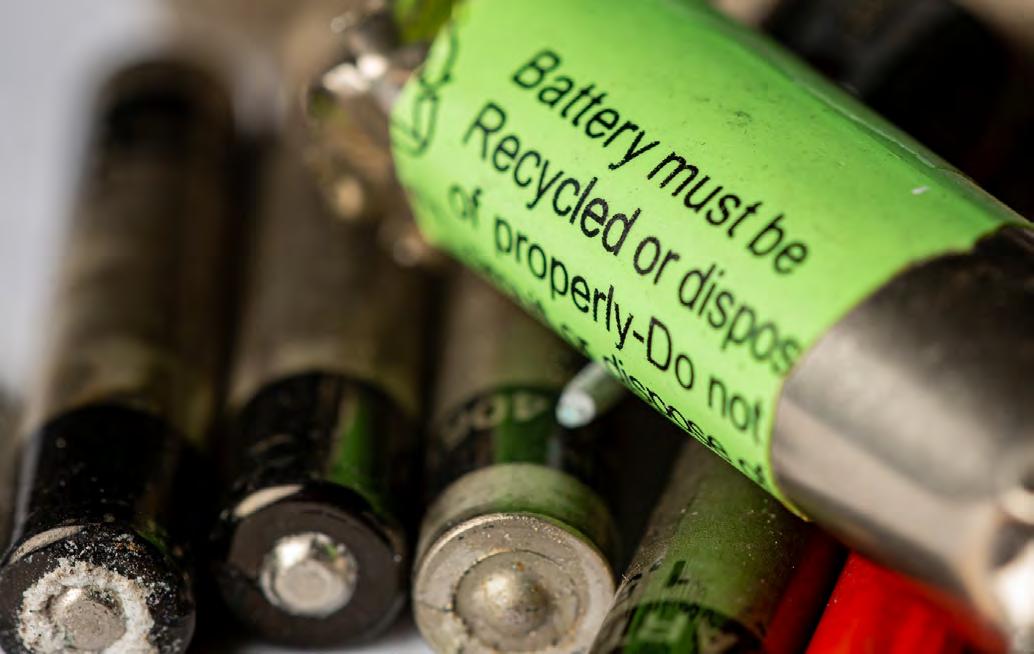
1 minute read
Julia Alajoki, Sipi Seisko, Mari Lundström: Li carbonate and hydroxide products and their purities
from Materia 3/2023
Taking action against climate change through the transition to low-carbon energy requires new lithium intensive technologies for energy storage. For example, electromobility relies on Li-ion batteries (LIBs) that will require a manifold increase in minerals processing, potentially including, e.g., Li (40×) by 2040. This motivates the development of refining processes for primary and secondary Li resources, and increases interest towards different Li-intermediates and precipitates as well as purities of the recovered products. This article briefly summarizes commercial Li-salts and their purities, as well as purities of recycled lithium originating from waste batteries (Figure 1) with the focus on Li2CO3 and hydroxide salts. Additionally, a short introduction to the standardization of Li is presented as a continuation to the article entitled Vihreän tulevaisuuden materiaalit (Materials for a greener future) published in Materia 3/2020 by Frans Nilsén (METSTA).
Li in battery manufacturing
LIB cell consists of cathode, anode, current collectors, electrolyte, separator, and cell casing [1]. Prior to the actual LIB cell manufacturing process, the cathode active materials (CAMs) need to be synthesized. Cathode materials consist of transition metal (e.g. Co, Ni, Mn) oxides containing lithium, the structure allowing lithium ions to diffuse out and back in during charging and discharging of battery. However, also alternative chemistries including lithium iron phosphate (LFP) are taking a large share of the battery market. In this article LFP batteries are excluded.
There are several methods used in CAM synthesis, co-precipitation being widely used. High purity metal salts, such as Ni, Co, Mn sulfates, are used as primary raw materials in the first stage of cathode materials production. In the process, these metal salts are mixed with the target ratio to produce cathode material precursor pCAM mixture in alkaline conditions. Next, pCAM is subjected to calcination with high purity lithium salt. In this article lithium carbonate and lithium hydroxide are considered as the possible lithium sources. Lithium carbonate is mainly used for producing low-Ni (less than 10%) CAMs and lithium hydroxide when the Ni concentration is high (10–30% of nickel). When lithium hydroxide is used as the lithium source, the calcination process can be performed at a lower temperature as compared to the use of lithium carbonate. [2,3].
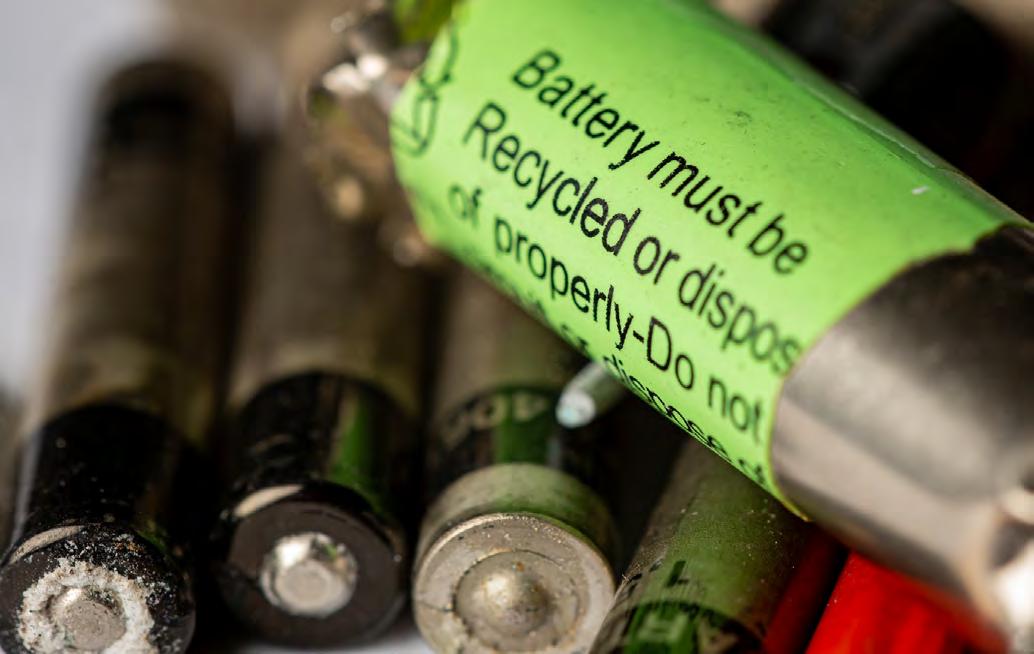
Primary Li production is dominated by Australia (Li concentrate) and Chile (Li carbonate). However, recently the Finland-based production by Sibanye-Stillwater´s Keliber lithium hydroxide project has announced being already in the construction phase. Also, CAM (and pCAM) production is mainly located in Asia, but industrial operation in Finland is also getting increasing focus. Umicore Finland Oy has pCAM production in Kokkola and is planning its expansion, while also BASF and CNGR (partly owned by Finnish Minerals Group) are planning pCAM production in Harjavalta and Hamina, as indicated by the applied environmental permits. In addition, CAM production is being planned at Kymenlaakso in Kotka in a joint venture between FMG and Beijing Easpring.
The Vaasa region is also gaining attention as environmental impact assessment programs have been submitted during the spring 2023 for CAM and graphite material plants located in the GigaVaasa industrial area. [4, 5].
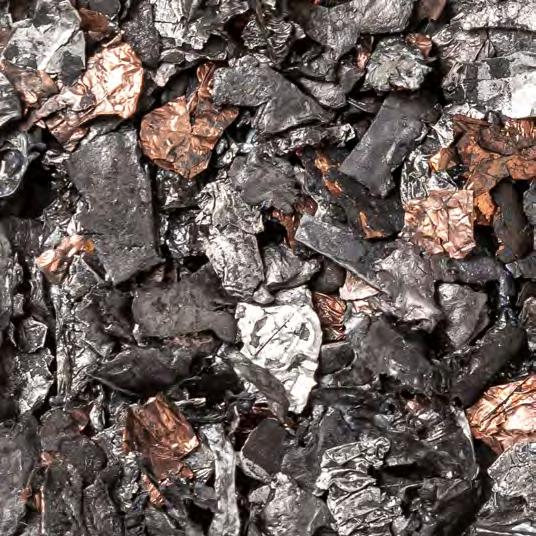
European Battery regulation for battery recycling and recycled content in batteries
The treatment and approach of waste batteries have been regulated by Directive 2006/66/EC [6]. However, as a part of European Green deal, the new upcoming European Battery regulation will replace Battery Directive aiming at a more sustainable and circular battery value chain. The regulation will require increasing amounts of battery materials to be recycled and recovered as well as recycled battery materials to be used in battery manufacturing. Therefore, the purity of recycled lithium salts is of increasing interest for future battery recycling and production industry. Additionally, element specific recycling targets will be set, the recovery target for lithium increasing up to 50% by 2027 and to 80% by 2031 [7]. In recycling processes, Li is typically recovered as carbonate or hydroxide. Alternative recovery routes are being constantly developed, e.g., via phosphate precipitation.
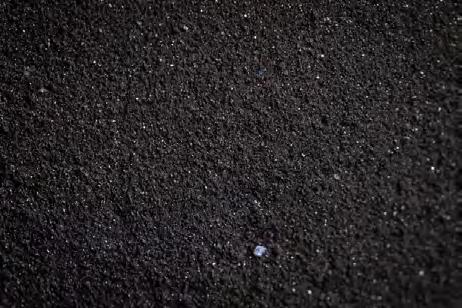
Commercial lithium carbonate salts
The manufacturing processes and the origin of lithium vary between commercial actors. The most common source of lithium is brine with close to 60% of the identified global reserves. Other sources for lithium are hard-rocks (~30%) as well as sediment hosted deposits (<3%). Lithium salts produced from brine typically contain more impurities as compared to those originated from hard-rocks as the lithium concentrate is produced by evaporation. [8]. In the current paper, commercial salts and their purities were investigated from the following chemical providers; Targay [9], Leverton [10], Livent [11], China Lithium Products Technology Ltd [12] and Albemarle [13]. As evident, the impurities and their amounts are highly dependent on the origin, but the challenge is that the lithium source is often not disclosed by the commercial actors.
The minimum purity level of commercial battery grade Li2CO3 was found to be 99.5%, while the highest purity level reported by the manufacturer in the commercial salts was up to 99.999%. Battery grade Li2CO3 is advertised and sold under three different grades: Battery, Enhanced and Superior, where the latter refers to the purest grade. Grade “Battery” refers in this article to a purity level of 99.5% ≤ Li2CO3 < 99.9%, “Enhanced” refers to a purity level of 99.9% and “Superior” for purities over 99.9%.
All commercial Li2CO3 salts had Ca, Fe, and Na as impurities. Both Ca (50–400 ppm) and Na (20–600 ppm) in addition to chlorides (35–300 ppm), sulfates (30–1000 ppm) and acid insolubilities (200 ppm) were among the major impurities. The concentration of other impurities was at maximum 50 ppm (i.e., Al, Cd, Co, Cr, Cu, Fe, K, Mn, Mg, Ni, Pb, Zn, and Si). The reported water content varied from 3000 to 6000 ppm.
It is obvious that the share and number of impurities reduces clearly as the purity level increases. However, the typical impurities and their concentration vary a lot even between the same grade of commercial Li salts. This may be due to the different manufacturing processes and the aimed used/applications where the Li salt will be used. For example, certain impurities present in brines (e.g. Na, Mg, Cl, sulfate) are technically hard to remove without producing technical grade carbonate in the first stage and battery grade only in the second purification process. The impurity ranges of the examined commercial chemicals are presented in Table 1.
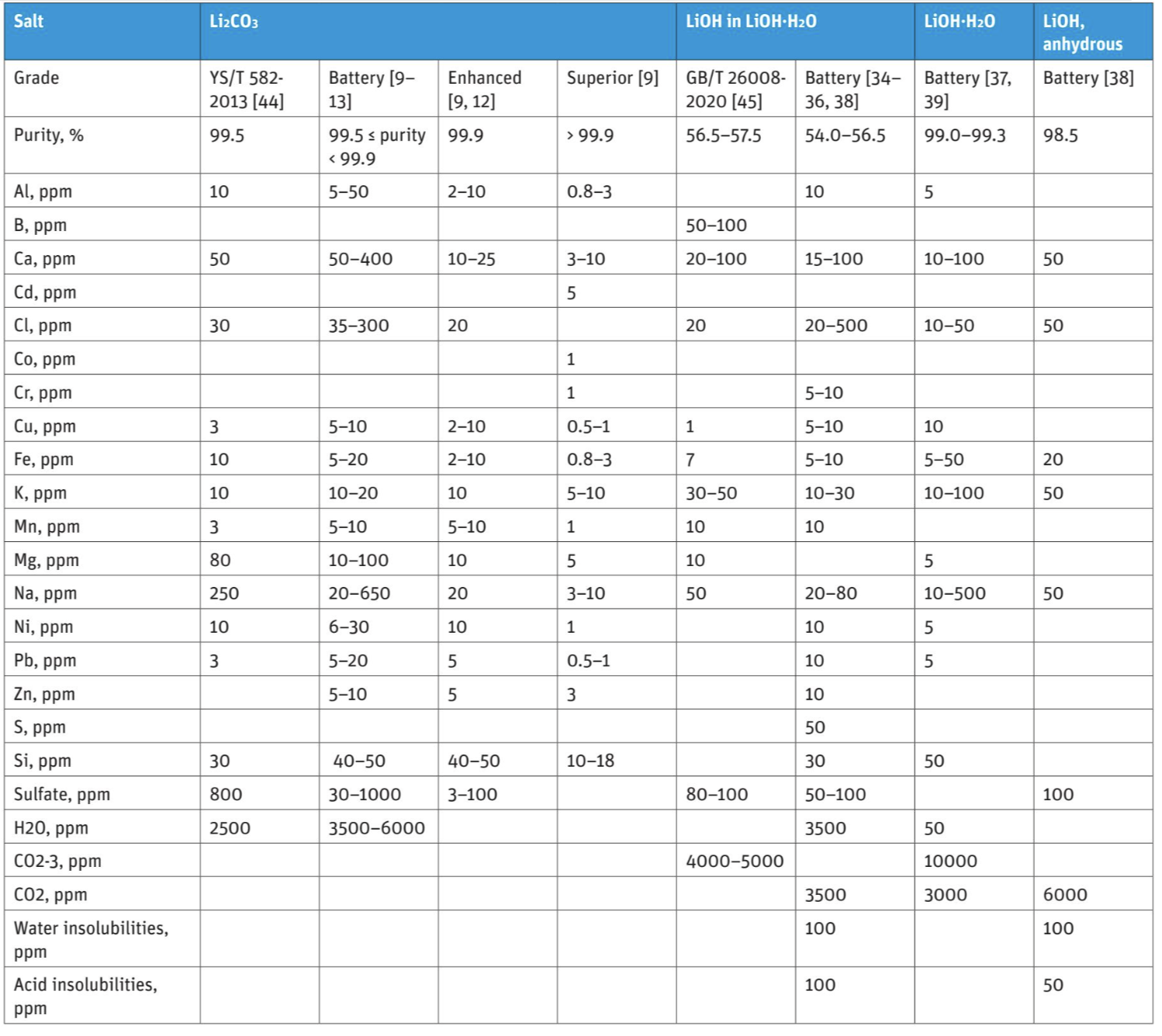
Recycled Li2CO3 from battery waste
Literature review was conducted to study different recycling approaches presented in scientific literature, with the focus on lithium recovery (Li2CO3) and its purity (if reported). Typically, raw materials used in the battery recycling studies vary from synthetic chemicals to manually dismantled fractions and up to industrially collected and treated battery waste. This has an impact on the impurities exposed to processing. Industrial battery waste is heterogenous, metallic elements concentrating on larger particle size fractions (Figure 2) whereas active materials and lithium concentrate on the smaller particle size fractions, i.e. black mass (Figure 3).
In most of the recycling processes, the raw material is treated by acidic leaching with reductant to extract both lithium and transition metals into the solution from the cathode materials. Most commonly studied leaching solutions are mineral acids (such as sulfuric acid and hydrochloric acid). However, a wide variety of other leaching media has also been reported. In all studied processes, some kind of solution purification steps are necessary (e.g. by precipitation and solvent extraction units) prior to Li precipitation. All reviewed studies also used Na2CO3 as precipitation agent in Li2CO3 recovery. Additionally, pre-treatment operations, such as roasting, can be used to promote leaching and its selectivity in the desired leaching media.
Recycling process cases
Wang et al. [14] studied chloride-based processing for lithium recovery using synthetic raw materials from reagent grade CAMs (LCO, LMO, and NMC111). Material was subjected to leaching, the solution was purified and Li2CO3 was recovered using saturated Na2CO3 at a temperature close to 100 °C. In this process, the achieved purity of Li2CO3 was 96.97% and the analyzed impurities were Na (2.21%) and Rb (0.1%), leaving 0.72% for the other impurities. The recovery of Li was 80±1%.
Opposite to Wang et al. [14], Atia et al. [15] studied sulfuric acid-based processing using industrial battery waste. In their research, black mass was subjected to reductive leaching (H2SO4−H2O2), solution purification was performed and finally, Li2CO3 was recovered. At highest, 72% recovery and 99.8% purity was achieved for Li2CO3 with Na as an impurity. In addition, also other industrial residues, such as LiF-rich spent electrolyte of aluminum production, have been subjected for studies in sulfuric acid leaching in order to achieve battery purity Li2CO3 [16].
The use of various kinds of selective pre-treatments has been reported in the literature. For example, Peng et al. [17] used nitration and selective roasting as a pre-treatment for lithium recycling from industrially treated waste LIBs (rich with LCO and NMC111). The used pre-treatment allowed lithium to form nitrates, accessible for selective leaching directly in water. The purity of Li2CO3 was 99.95% and 90% of the lithium was recovered. Na (300 ppm), nitrate (30 ppm), 10 ppm of Fe, Zn, and Al as well as <10 ppm of Cu, Co and Mn were detected as impurities.
Natarajan et al. [18] studied recovering lithium both from cathode and anode materials from spent LIBs used in mobile phones. The raw material was manually dismantled and separated to the following fractions: cathode, anode and separator materials. In processing, cathode material separation from aluminum was complex consisting of immersion in dimethylformamide and followed by PDF binder removal by calcination. The anode material (graphite) was detached from copper by ultrasonication in water and then separated by centrifugation. Only after these excessive pre-treatments, 3 M acetic acid (+H2O2) was applied for cathode material leaching and water for lithium extraction from the anode material. The purity of Li2CO3 was 99.4% (cathode) and 99.7% (anode). The recovered Li2CO3 from cathode contained Co (700 ppm), Mn (3300 ppm), Ni (500 ppm), Al (300 ppm) and Na (1300 ppm) as impurities. Li2CO3 from anode material contained Co (600 ppm), Mn (500 ppm), Ni (100 ppm), Al (300 ppm), Na (1000 ppm) and Cu (500 ppm) as impurities.
Furthermore, Higuchi et al. [19] studied lithium recovery from several different cathode materials (LMO, LCO, LiNi 0.85Co0.15O2, NMC111), using water and Na2S2O8 as the leaching chemicals, and resulting sulfate-based solution. The investigated raw materials were provided by chemical industry. Purities of recovered Li2CO3 were following: 99.6% (LMO), 100% (LCO), 99.4% (LiNi0.85Co0.15O2) and 99.5% (NMC111). Na was reported as an impurity for Li2CO3 produced from LMO (3400 ppm), LiNi0. 85Co0.15O2 (5000 ppm), and NMC111 (4000 ppm).
Purities of recycled Li2CO3
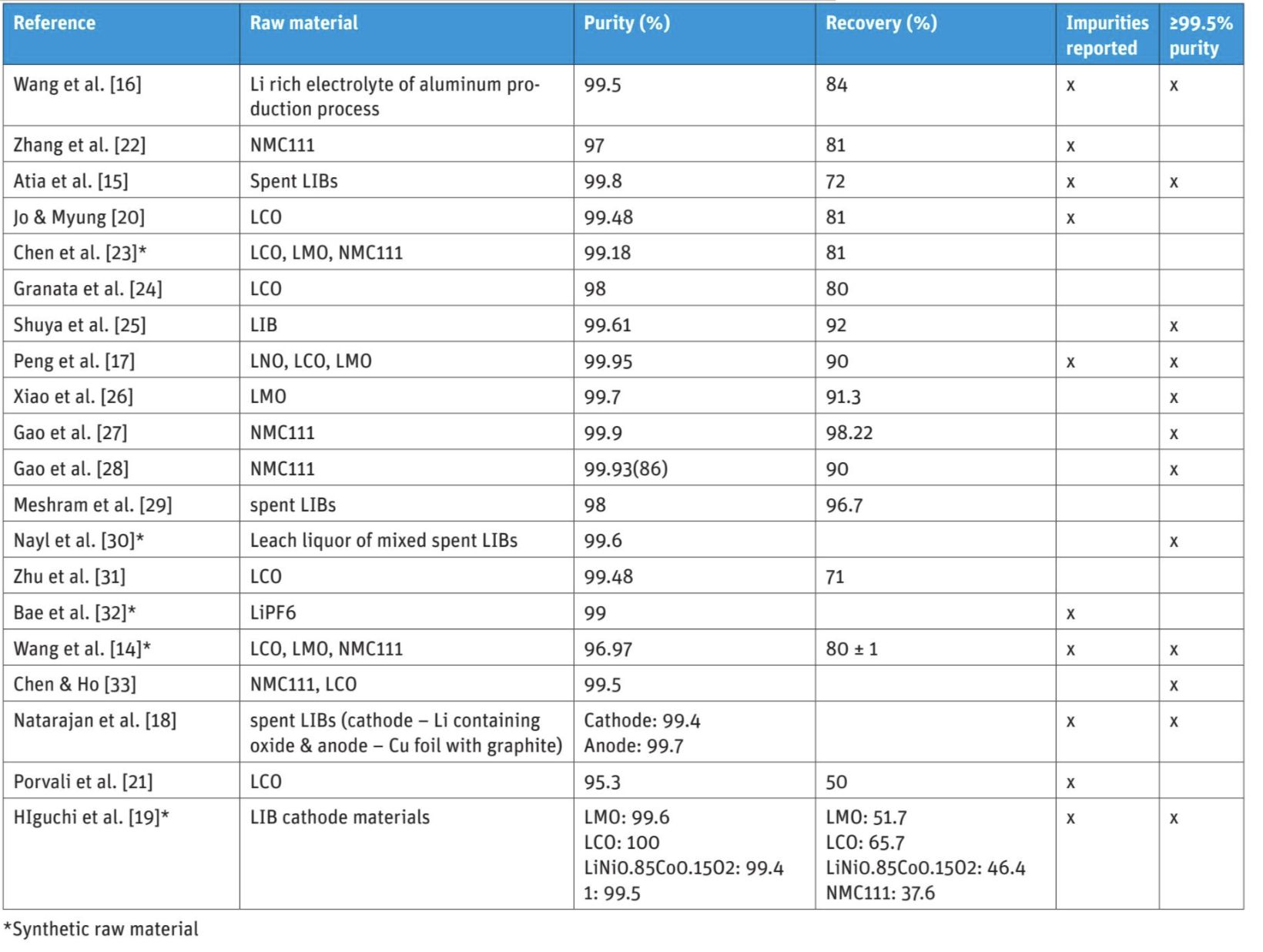
The purity of Li recovered as Li2CO3 was reviewed from 20 different recycling studies [14–33], presented in Table 2. The used analysis methods in these studies were XRD, SEM, ICP-OES and AAS. The used raw material, purity level of the produced salt and recovery rate are included, and it is further indicated, whether the purity meets ≥99.5%, which was shown to be the minimum purity level for commercial battery grade Li carbonate products. It should be noted that the lithium recovery stream between the recycling studies may vary and that the purity targets may vary as well - as future business models may also be based on lithium carbonate production as intermediate product to be subjected for further lithium purification.
The summary suggests that the most common impurity in Li2CO3 products is Na (310–22100 ppm) followed by Mn (60–3300 ppm) and Al (80–8000 ppm). In addition, Ca was analyzed in certain studies (120–360 ppm). The presence of Cu varied from <10 to 500 ppm and the presence of Co from <10 to 740 ppm, whereas Fe was occasionally analyzed (10–380 ppm).
Furthermore, Jo & Myung [20] reported impurities in more detail including Cl (420 ppm), Mg (410 ppm), K (390 ppm), and B (260 ppm), while Porvali et al. [21] reported B (30 ppm), Ba (20 ppm), and Mn (960 ppm) as impurities from LCO type of battery waste. The published characterization results of the recycled lithium carbonate products indicate that the recycled Li-products may contain a wider number of impurities when compared to commercial battery grade lithium salts due to the complex multi-metal composition of a LIB. It is also likely that in the published recycling research the final lithium recovery process is less optimized and conceptualized from both recovery and purity point of view and does not typically include a secondary lithium salt purification process.
Commercial lithium hydroxide salts
Commercial hydroxide salts and their purities were investigated from the following chemical providers; ThermoFisher [34], Livent [35], Halmek Lithium [36], Nanografi [37], Ganfeng Lithium [38] and Targay [39]. The products presented were lithium hydroxide monohydrate (LiOH·H2O) or anhydrous lithium hydroxide (LiOH). The purity levels for commercially available battery grade LiOH·H2O were determined to be between 54.0−56.5% for LiOH content, while the total purity levels for LiOH·H2O were reported to be 99.0−99.3%. The purity of anhydrous battery grade LiOH was reported to be 98.5%.
In summary, the different products contained a total of 21 different impurities, which can be categorized into three groups based on their concentration levels. The major impurities in lithium hydroxides were carbonates (<10000 ppm), carbon monoxide (3000–3500 ppm) as well as Na and chlorides (10–500 ppm). The mid-level impurities included Ca, K, acid and water insolubilities as well as sulfates (<100 ppm). The minor impurities included Al, Cu, Cr, Fe, Mn, Mg, Ni, Pb, and Zn (maximum in few tens of ppm). All commercial LiOH products were reported to contain Fe, K, Na, and chlorides due to their problematic nature in different applications. For example, K and Na tend to replace Li in the matrix and Fe is a contaminant for glass applications. All impurities and their concentration ranges are listed in Table 1.
Recycled lithium hydroxide from battery waste
Only two studies were found, in which Li was recovered as LiOH·H2O from battery waste, and both of these managed to produce battery grade LiOH·H2O comparable to the commercial ones.
Liu et al. [40] studied an innovative route for lithium extraction from spent LIBs containing Li, Co, Ni, Cu, Al, Mn, Fe, and C. Battery grade LiOH·H2Owas produced via reductive hydrogen roasting and water leaching. The purity of the recovered LiOH·H2O product was 99.92% containing 57.10% of LiOH. As impurities the produced LiOH·H2O contained Al (80 ppm) and Na, Ni, Co, Mn, Cu and Fe (<10 ppm).
Park et al. [41] studied LiOH·H2O recovery from NCA based waste CAMs. The black powder was de-lithiated and leached in water. The Li containing solution went through a series of crystallization, washing and filtration before drying. The purity of the produced LiOH·H2O was 99.5% containing 56.5% of LiOH. Na (33 ppm) was observed as an impurity, but Ca and Fe were not detected.
Standardization of Li salts
Standardization may have several advantages, such as increasing the quality in operation or product as well as improving safety and the combability of products and services. The standards are used by companies and organizations all around the world for different purposes. Standards related to lithium are still under progress, and they may, e.g., handle the analysis methods of lithium, which is currently the aim of technical ISO committees. Additionally, material specification related to, e.g., lithium product purity are currently in use in China (Li hydroxide and carbonate).
ISO/TC 333 Lithium
ISO/TC 333 is a technical committee founded in summer 2020 and initiated by China to develop ISO standardization in the field of lithium covering the whole value chain from mining to recycling and reuse. The main goal is to remove the technical barriers between standards for different nations.
The technical committee consists of several working groups (WG) and the standardization of lithium hydroxide analysis methods is under WG2, whereas lithium carbonate is under WG3. In addition, an Ad Hoc Group (AHG1 Analysis Methods) has been established under the technical committee to unify the standards for chemical analysis methods and thus make the standardization process more efficient.
The standardization process of lithium is at the very beginning and will most likely take 2–3 years to achieve a mutual agreement between the parties (countries). Each party has one vote and their opinions and goals for the standardization of lithium vary.
At this point, the contents of the Li standards have only been determined by the title level. Currently, the focus of Li salt standardization is to standardize the used analysis methods to investigate purity levels and the impurity content instead of strict material specifications.
Chinese Li standards
At the moment, China is nationally using standards for Li salts. According to GB/T 11064.1-2013 [42] and GB/T 11064.22013 [43] (Table 1), the determination of the purity level of lithium salts (Li2CO3 and LiOH·H2O) is determined by acid-alkali titrimetric method. A sample of a salt is dissolved in hydrochloric acid standard titration solution. Methyl red–bromocresol green is used as an indicator. The consumed amount of acid is used to calculate the content of Li2CO3 and LiOH·H2O. Calcium content in the test sample will be converted into lithium carbonate content and correspondingly sodium and potassium content in a test sample will be converted to lithium hydroxide monohydrate.
YS/T 582-2013 [44] states that Battery grade Li2CO3 requirements are ≥ 99.5% purity and a d50 value between 3–8 µm and d90 between 9–15 µm. By appearance, the product is a white powder without any visible impurities. The standard also determines the maximum magnetic impurity content (3 ppm). The accepted impurity levels were stated for Na (<250 ppm), sulfates (<800 ppm) and water (<2500 ppm).
Based on Chinese standard GB/T 260082020 [45], battery grade lithium hydroxide monohydrate can be divided in three designations according to the chemical composition. By appearance, battery grade lithium hydroxide monohydrate can be divided into crystal type and fine powder. LiOH content is required to be 56.5–57.5% and a d50 value to be 3–20 µm for all designations. The allowed magnetic impurity content varies from 0.05 to 0.2 ppm depending on the designation. The impurity limits for both Chinese lithium salt standards are presented in Table 1. It should be noted that Chinese lithium standards are defined for lithium salts produced from hard-rock which naturally contain less impurities as compared to the ones originated from brine.
Highlights of the research results
Increasing use of batteries and the ambitious target to recover up to 80% of lithium by 2031 set by EC (Battery regulation) highlights the importance of development of competitive technologies for Li recovery from LIB waste. Also, the focus in recycling process and business model development should be directed to optimizing the purity of recovered final lithium products (or intermediates with further purification), to allow their efficient integration back to the value chain and use in battery manufacturing.
From the commercial Li salt products, the typical minimum purity level for Li2CO3 was found to be 99.5%. The purity levels for LiOH·H2O were determined to be between 54.0–56.5% for LiOH content, while the total purity levels for LiOH·H2O were reported to be 99.0−99.3%. In addition, an anhydrous battery grade LiOH was advertised with purity level of 98.5%.
Some of the recycled and recovered lithium salts reported in the open literature were summarized and the results indicated that in general there may appear higher quantity and concentrations of impurities in the recycled products. However, several of the products could still achieve purities similar to commercial grade lithium salts. Also, the effect of impurities during CAM production and further in battery operation is unclear, as the industry has historically operated only with high purity chemicals, however mixing them in controlled ratio with several other (high purity) elements.
The standardization in the field of lithium is under development and different parties (countries) have different targets in the standardization work. At this point of the discussion, most of the western countries seem to aim at lithium standardization that focuses on the analysis methods of purity, rather than at the product purity itself. In such case the material specifications will remain between the industrial actors and customers.
Acknowledgements
The financial support during the years from Business Finland, BATCircle2.0 (grant number 44886/31/2020) is acknowledged as well as an overview for the ISO standardization situation of lithium by Frans Nilsén (METSTA). In addition, comments by Pyry Hannula (FMG) and Liisa Haavanlammi (Materia) are highly appreciated. ▲
References
[1] Velázquez-Martínez, O., Valio, J., Santasalo-Aarnio, A., Reuter, M., & Serna-Guerrero, R. (2019). A critical review of lithium-ion battery recycling processes from a circular economy perspective. Batteries, 5(4), 68. http://dx.doi.org/10.3390/batteries5040068
[2] Jo, S., Han, J., Seo, S., Kwon, O.S., Choi, S., Zhang, J., Hyun, H., Oh, J., Kim, J., Chung, J., Kim, H., Wang, J., Bae, J., Moon, J., Park, Y.C., Hong, M.H., Kim, M., Liu, Y., Sohn, I., Jung, K. & Lim, J. (2022). Solid-State Reaction Heterogeneity During Calcination of Lithium-Ion Battery Cathode. Advanced Materials, 2207076. https://doi.org/10.1002/adma.202207076
[3] Li, W., Erickson, E. M., & Manthiram, A. (2020). High-nickel layered oxide cathodes for lithium-based automotive batteries. Nature Energy, 5(1), 26-34. https://doi.org/10.1038/ s41560-019-0513-0
[4] Finnish Minerals Group. Finnish Battery Chemicals on jättänyt akkumateriaalien tuotantoa koskevan Yva-selostuksen. [Cited 6.4.2023]. Available at: https://www.mineralsgroup. fi/fi/ajankohtaista/uutiset/finnish-battery-chemicals-on-jattanyt-akkumateriaalien-tuotantoa-koskevan-yva-selostuksen. html?p81=7&news_tag=
[5] Finnish Minerals Group. Yva-menettely Vaasan anodimateriaalitehtaasta käynnistyy. [Cited 6.4.2023]. Available at: https://www. mineralsgroup.fi/fi/ajankohtaista/uutiset/ yva-menettely-vaasan-anodimateriaalitehtaasta-kaynnistyy.html
[6] Directive on batteries and accumulators and waste batteries and accumulators (2006), Directive 2006/66/EC, OJ L 266/1.
[7] European Commission (2022, December 9). Green Deal: EU agrees new law on more sustainable and circular batteries to support EU’s energy transition and competitive industry. [Cited 8.5.2023]. Available at: https://ec.europa.eu/commission/presscorner/detail/en/ ip_22_7588
[8] Desaulty, A. M., Monfort Climent, D., Lefebvre, G., Cristiano-Tassi, A., Peralta, D., Perret, S., Urban, A. & Guerrot, C. (2022). Tracing the origin of lithium in Li-ion batteries using lithium isotopes. Nature Communications, 13(1), 4172. https://doi.org/10.1038/s41467022-31850-y
[9] Targay (2011, May 25). Lithium Carbonate. Product data sheet. [Cited 24.1.2023]. Available at: https://www.targray.com/content-data/mediafiles/images/documents/pds-lithium-carbonate.pdf
[10] Leverton Lithium Chemicals. Lithium Carbonate Battery Grade 99.5%. 4236DS09 datasheet. [Cited 24.1.2023]. Available at: https://levertonprod.wpenginepowered.com/ wp-content/uploads/2018/11/4236_Lithium_ Carbonate_Battery_Grade_99.5__0.pdf
[11] Livent (2022, September 15). Lithium Carbonate, Battery Grade. QS-PDS-1059 datasheet. [Cited 24.1.2023]. Available at: https:// livent.com/wp-content/uploads/2022/09/ QS-PDS-1059-r4-Lithium-Carbonate-BatteryGrade-Product-Website.pdf
[12] China Lithium Products Technology Ltd. Li2CO3 99.99% Battery Grade. [Cited 8.12.2022]. Available at: http://lithium-chemical.com/products_13/66.html
[13] Albemarle (2017, December 12). Lithium Carbonate, battery grade < 40 micron. [Cited 24.1.2023]. Available at: https://www.albemarle.com/products/lithium-carbonate-battery-grade-40-micron
[14] Wang, R.C., Lin, Y.C., & Wu, S.H. (2009). A novel recovery process of metal values from the cathode active materials of the lithium-ion secondary batteries. Hydrometallurgy, 99(34), 194-201. http://dx.doi.org/10.1016/j.hydromet.2009.08.005
[15] Atia, T.A., Elia, G., Hahn, R., Altimari, P., & Pagnanelli, F. (2019). Closed-loop hydrometallurgical treatment of end-of-life lithium ion batteries: Towards zero-waste process and metal recycling in advanced batteries. Journal of Energy Chemistry, 35, 220-227. https://doi. org/10.1016/j.jechem.2019.03.022
[16] Wang, W., Chen, W., & Liu, H. (2019). Hydrometallurgical preparation of lithium carbonate from lithium-rich electrolyte. Hydrometallurgy, 185, 88-92. https://doi. org/10.1016/j.hydromet.2019.02.013
[17] Peng, C., Liu, F., Wang, Z., Wilson, B. P., & Lundström, M. (2019). Selective extraction of lithium (Li) and preparation of battery grade lithium carbonate (Li2CO3) from spent Li-ion batteries in nitrate system. Journal of Power Sources, 415, 179-188. https://doi. org/10.1016/j.jpowsour.2019.01.072
[18] Natarajan, S., Boricha, A.B., & Bajaj, H.C. (2018). Recovery of value-added products from cathode and anode material of spent lithium-ion batteries. Waste Management, 77, 455-465. https://doi.org/10.1016/j.wasman.2018.04.032
[19] Higuchi, A., Ankei, N., Nishihama, S., & Yoshizuka, K. (2016). Selective recovery of lithium from cathode materials of spent lithium ion battery. Jom, 68, 2624-2631. https://doi. org/10.1007/s11837-016-2027-6
[20] Jo, C.H., & Myung, S.T. (2019). Efficient recycling of valuable resources from discarded lithium-ion batteries. Journal of Power Sources, 426, 259-265. https://doi.org/10.1016/j. jpowsour.2019.04.048
[21] Porvali, A., Aaltonen, M., Ojanen, S., Velazquez-Martinez, O., Eronen, E., Liu, F., Wilson, B.P., Serna-Guerrero, R. & Lundström, M. (2019). Mechanical and hydrometallurgical processes in HCl media for the recycling of valuable metals from Li-ion battery waste. Resources, Conservation and Recycling, 142, 257-266. https://doi.org/10.1016/j.resconrec.2018.11.023
[22] Zhang, X., Bian, Y., Xu, S., Fan, E., Xue, Q., Guan, Y., Wu, F., Li, L. & Chen, R. (2018). Innovative application of acid leaching to regenerate Li (Ni1/3Co1/3Mn1/3)O2 cathodes from spent lithium-ion batteries. ACS Sustainable Chemistry & Engineering, 6(5), 5959-5968. http://dx.doi.org/10.1021/acssuschemeng.7b04373
[23] Chen, X., Chen, Y., Zhou, T., Liu, D., Hu, H., & Fan, S. (2015). Hydrometallurgical recovery of metal values from sulfuric acid leaching liquor of spent lithium-ion batteries. Waste management, 38, 349-356. http://dx.doi. org/10.1016/j.wasman.2014.12.023
[24] Granata, G., Moscardini, E., Pagnanelli, F., Trabucco, F., & Toro, L. (2012). Product recovery from Li-ion battery wastes coming from an industrial pre-treatment plant: Lab scale tests and process simulations. Journal of Power Sources, 206, 393-401. https://doi. org/10.1016/j.jpowsour.2012.01.115
[25] Shuya, L., Yang, C., Xuefeng, C., Wei, S., Yaqing, W., & Yue, Y. (2020). Separation of lithium and transition metals from leachate of spent lithium-ion batteries by solvent extraction method with Versatic 10. Separation and Purification Technology, 250, 117258. https:// doi.org/10.1016/j.seppur.2020.117258
[26] Xiao, J., Li, J., & Xu, Z. (2017). Recycling metals from lithium-ion battery by mechanical separation and vacuum metallurgy. Journal of hazardous materials, 338, 124-131. https:// doi.org/10.1016/j.jhazmat.2017.05.024
[27] Gao, W., Zhang, X., Zheng, X., Lin, X., Cao, H., Zhang, Y., & Sun, Z. H. I. (2017). Lithium carbonate recovery from cathode scrap of spent lithium-ion battery: a closed-loop process. Environmental science & technology, 51(3), 1662-1669. http://dx.doi.org/10.1021/ acs.est.6b03320
[28] Gao, W., Song, J., Cao, H., Lin, X., Zhang, X., Zheng, X., Zhang, Y. & Sun, Z. (2018). Selective recovery of valuable metals from spent lithium-ion batteries–process development and kinetics evaluation. Journal of cleaner production, 178, 833-845. https://doi. org/10.1016/j.jclepro.2018.01.040
[29] Meshram, P., Pandey, B.D., & Mankhand, T.R. (2015). Hydrometallurgical processing of spent lithium-ion batteries (LIBs) in the presence of a reducing agent with emphasis on kinetics of leaching. Chemical Engineering Journal, 281, 418-427. http://dx.doi. org/10.1016/j.cej.2015.06.071
[30] Nayl, A.A., Hamed, M.M., & Rizk, S.E. (2015). Selective extraction and separation of metal values from leach liquor of mixed spent Li-ion batteries. Journal of the Taiwan Institute of Chemical Engineers, 55, 119-125. http://dx. doi.org/10.1016/j.jtice.2015.04.006
[31] Zhu, S.G., He, W.Z., Li, G.M., Xu, Z., ZHANG, X.J., & Huang, J.W. (2012). Recovery of Co and Li from spent lithium-ion batteries by combination method of acid leaching and chemical precipitation. Transactions of Nonferrous Metals Society of China, 22(9), 2274-2281. https://doi.org/10.1016/S10036326(11)61460-X
[32] Bae, H., Hwang, S.M., Seo, I., & Kim, Y. (2016). Electrochemical lithium recycling system towards renewable and sustainable energy technologies. Journal of the Electrochemical Society, 163(7), E199. http://dx.doi. org/10.1149/2.0691607jes
[33] Chen, W.S., & Ho, H.J. (2018). Recovery of valuable metals from lithium-ion batteries NMC cathode waste materials by hydrometallurgical methods. Metals, 8(5), 321. http:// dx.doi.org/10.3390/met8050321
[34] Thermo Fisher (2022, December 12). Lithium hydroxide monohydrate, battery grade. Specification sheet. [Cited 12.12.2022]. Available at: https://www.thermofisher.com/order/catalog/product/H36379.0B
[35] Livent. Lithium hydroxide monohydrate, battery grade. QS-PDS-1021 data-sheet. [Cited 12.12.2022]. Available at: https://livent. com/wp-content/uploads/2018/09/QS-PDS1021-r3.pdf
[36] Halmek Lithium. Lithium hydroxide monohydrate battery grade. [Cited 13.12.2022]. Available at: https://halmeklithium.com/ media/1242/battery-grade-en.pdf
[37] Nanografi. Lithium Hydroxide, Monohydrate (Battery Grade, LiOH.H2O), Purity: ≥ 99.0%. [Cited 13.12.2022]. Available at: https://nanografi.com/battery-equipment/lithium-hydroxide-monohydrate-battery-grade-lioh-h2o-purity-99-0/
[38] Ganfeng Lithium. Lithium hydroxide. [Cited 24.3.2023]. http://www.ganfenglithium.com/ pro2_detail_en/id/5.html
[39] Targay (2011, May 19). Lithium Hydroxide. Product data sheet. [Cited 13.12.2022]. Available at: https://www.targray.com/content-data/mediafiles/images/documents/ pds-lithium-hydroxide.pdf
[40] Liu, F., Peng, C., Ma, Q., Wang, J., Zhou, S., Chen, Z., Wilson, B. P. & Lundström, M. (2021). Selective lithium recovery and integrated preparation of high-purity lithium hydroxide products from spent lithium-ion batteries. Separation and Purification Technology, 259, 118181. https://doi. org/10.1016/j.seppur.2020.118181
[41] Park, J.S., Seo, S., Han, K., Lee, S., & Kim, M.J. (2023). A process using a thermal reduction for producing the battery grade lithium hydroxide from wasted black powder generated by cathode active materials manufacturing. Journal of Hazardous Materials, 448, 130952. https://doi.org/10.1016/j. jhazmat.2023.130952
[42] GB/T 11064.1-2013. (2013). Methods for chemical analysis of lithium carbonate, lithium hydroxide monohydrate and lithium chloride. Part 1: Determination of lithium carbonate content -- Acid-alkali titrimetric method. China: The People’s Republic of China’s non-ferrous metals industry standard. 8 p.
[43] GB/T 11064.2-2013. (2013). Methods for chemical analysis of lithium carbonate, lithium hydroxide monohydrate and lithium chloride. Part 2: Determination of lithium hydroxide content -- Acid-alkali titrimetric method. China: The People’s Republic of China’s non-ferrous metals industry standard. 8 p.
[44] YS/T 582-2013. (2013). Battery grade lithium carbonate. China: The People’s Republic of China’s non-ferrous metals industry standard. 11 p.
[45] GB/T 26008-2020. (2020). Battery grade lithium hydroxide monohydrate. China: The People’s Republic of China’s non-ferrous metals industry standard. 22 p.
TEKSTI: JULIA ALAJOKI, RESEARCH ASSISTANT, HYDROMETALLURGY AND CORROSION
SIPI SEISKO, POSTDOCTORAL RESEARCHER, HYDROMETALLURGY AND CORROSION
MARI LUNDSTRÖM, PROFESSOR (ASSOCIATE), HYDROMETALLURGY AND CORROSION
AALTO UNIVERSITY, SCHOOL OF CHEMICAL ENGINEERING, DEPARTMENT OF CHEMICAL AND METALLURGICAL ENGINEERING

